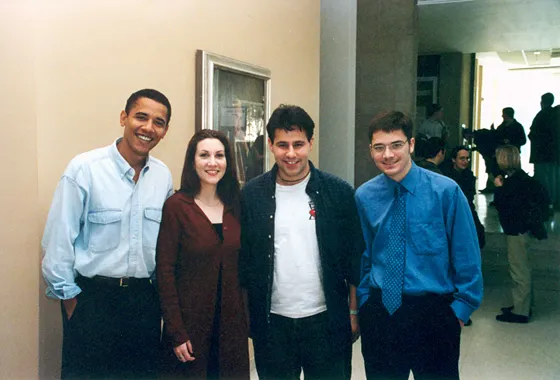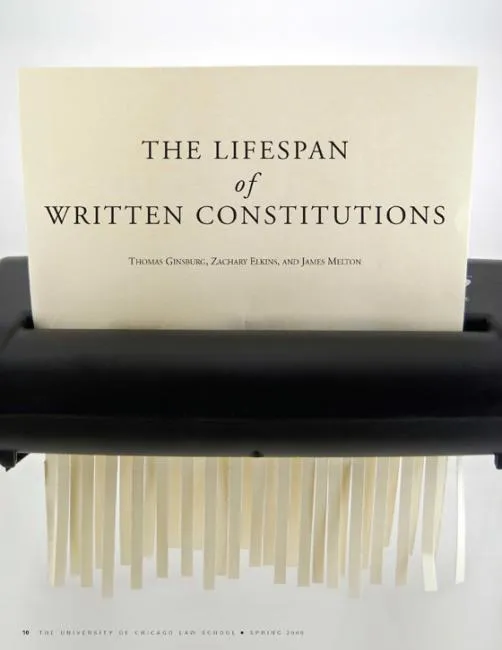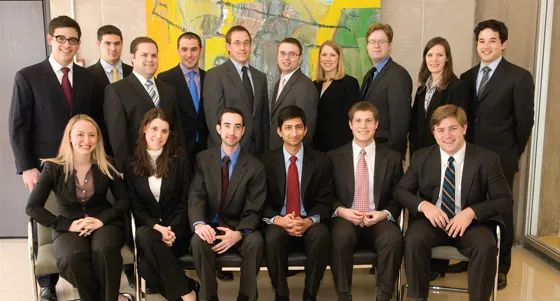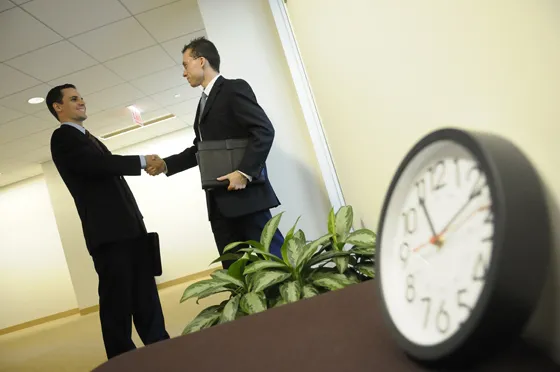Our Small Corner of the Obamaverse

On January 10, 2008, Marsha Nagorsky, ’95, the Law School’s Assistant Dean for Communications, got an e-mail from the Daily Herald, a suburban Chicago newspaper. The Herald was doing a story about Barack Obama and wanted to photograph a classroom that he had taught in. Nagorsky was confused at the time—she remembers thinking that it must be a slow news day if anyone was interested in photographing a Law School classroom for a story about a Presidential candidate. Little did she know then that she would field more than 100 such requests before President Obama was inaugurated just over a year later.
Both the Law School and, more generally, the University of Chicago have been home to influential and transcendent figures over the course of the past century. When Barack Obama announced his candidacy for President of the United States on a cold February day two years ago, the University—an institution that counts Nobel Prize winners, Attorneys General, CEOs, and quite a few celebrities among its ranks—prepared to receive the press inquiries, requests for interviews, random questions, and persistent phone calls about the former Senior Lecturer in Law that began during the Democratic primary and continued unabated through Inauguration Day. It turns out that all the preparation in the world doesn’t make you ready for the onslaught a presidential campaign brings.
As Law School liaisons in the University’s News Office, Sarah Galer and her colleague Julia Morse were responsible for fielding a majority of the e-mails and phone calls that streamed in from all corners of the world during Obama’s historic run, from China to Chile to the Philippines. Galer admitted that there was some anxiety about what the onslaught of media attention would bring and how it would reflect upon the University and Obama himself. The Law School did find itself involved in some controversy over Obama’s title. Obama referred to himself as a “constitutional law professor” on the campaign trail, and the Clinton campaign took him to task for it, saying that he had never held the title of Professor. The Law School decided to head off the reporters at the pass, released a statement clarifying his position as “Senior Lecturer,” and found itself in the middle of a war of words. In late March and early April, Nagorsky and Morse spent much of their time talking with reporters about Obama’s time at the Law School.
The scrutiny from reporters did not end there. Major news outlets continued to run stories throughout the summer and fall about Obama’s time at the Law School. The New York Times alone did three different stories—one on the front page—and asked Internet readers to opine on the exams Obama gave while teaching here. Stories featuring interviews with Law School faculty and alumni were covered by the Washington Post, Time magazine, the BBC, and all Chicago-area news outlets, just to name a few. “We spend so much time trying to get the press to write about what our faculty is doing,” said Nagorsky, “and all of a sudden we couldn’t turn around without seeing one of our faculty or alumni quoted. It was both exciting and exhausting to monitor.”
Nagorsky, Morse, and Galer spent a great deal of time in 2008 walking reporters around the Law School, sitting with them while they reviewed material—such as course evaluations—that they were not permitted to copy, setting up interviews with faculty, arranging photo shoots of the Law School and its classrooms, and providing all sorts of data to the media—such as exactly what classes Professor Obama taught when and how many people were enrolled in them. “Our biggest frustration was our lack of photos of Obama in the classroom,” said Nagorsky. “Because of his state senate obligations, Professor Obama taught mostly early on Mondays or late on Fridays, and we rarely photograph faculty then. If only we’d known … ”
Obama’s time at the Law School turned out to be free of the controversy and conflict such intense scrutiny would have surely uncovered. That in and of itself was often a source of confusion, as Senior Lecturer in Law Dennis Hutchinson recalled. “The domestic journalists seemed bewildered by how little impact outside the classroom Obama made while he was here, a choice, I tried to explain, that he made. The overseas journalists were charming for the most part and eager to understand American politics.”
Those foreign journalists made things a bit complicated, as they would often circumvent University protocol. “Occasionally I would get a phone call from the Law School’s receptionist announcing that a reporter from a small newspaper in Argentina or Belgium was at the front desk with a photographer, hoping to conduct a couple of interviews and snap some photos. I had to try as kindly as possible to explain to them that faculty and students couldn’t be available every minute of every day,” Nagorsky stated. Nagorsky said that her primary concern was shielding the students from as much of the media glare as possible. “It was of the utmost importance that our students’ day-to-day lives could proceed as usual, without all of the disruption and distraction the constant presence of photographers and camera crews in the Green Lounge or the library might bring.”


